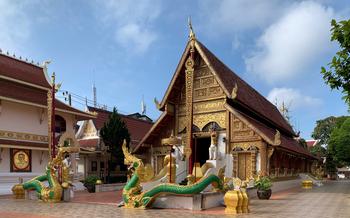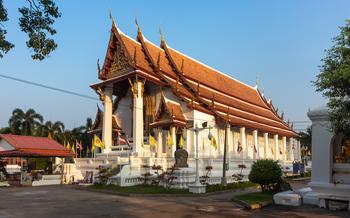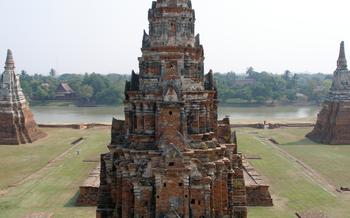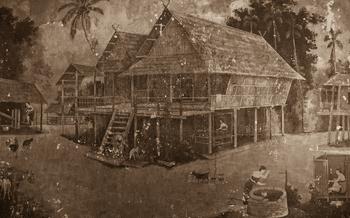
Wat Phra Non
- Wat Phra Non: An Overview
- Exploring the Temple Grounds
- The Majestic Stupa
- Buddha Images and Statues
- Ordination Hall and Monks' Quarters
- Pilgrimage and Religious Significance
- Community Involvement
- Visitor Etiquette and Dress Code
- Supporting the Temple
- Nearby Attractions
- Accommodation and Dining
- Insider Tip: Unveiling Wat Phra Non's Hidden Treasures
Wat Phra Non: An Overview
Wat Phra Non, a sacred Buddhist temple nestled in the heart of Mae Hong Son, Thailand, stands as a testament to the region's rich history and cultural heritage. Built over 600 years ago, the temple holds a significant position in the hearts of both local and international devotees. Its unique architectural features, coupled with its religious and cultural significance, have earned it a reputation as one of the most revered temples in the area.
The temple's most striking feature is its magnificent stupa, towering over the serene temple grounds. Adorned with intricate carvings and intricate designs, the stupa symbolizes the Buddhist concept of enlightenment and liberation. The temple complex also houses several notable buildings, including the ordination hall, where young men are ordained as Buddhist monks, and the monks' quarters, where the resident monks reside and practice their religious duties.
Wat Phra Non's location on the outskirts of Mae Hong Son town makes it easily accessible for visitors. The temple is surrounded by lush greenery and offers stunning views of the surrounding mountains, creating a serene and peaceful atmosphere. Its proximity to other tourist attractions, such as the Mae Hong Son Night Market and the Pha Sua Waterfall, makes it an ideal destination for those seeking a comprehensive cultural experience.
Exploring the Temple Grounds
Wat Phra Non's layout mirrors traditional Thai temple architecture, organized around a central courtyard surrounded by various buildings and structures. The main stupa dominates the complex, flanked by smaller stupas and Buddha images. Visitors are greeted by a grand entrance gate, leading to a paved walkway lined with intricate sculptures and bas-reliefs depicting scenes from Buddhist mythology.
Notable buildings within the grounds include the ordination hall, where monks receive their official vows, and the monks' quarters, where they reside and study. These structures showcase traditional Lanna-style architecture, evident in their wooden construction, ornate carvings, and sweeping roofs.
The temple grounds are adorned with beautifully landscaped gardens, featuring colorful flowers, tropical trees, and manicured lawns. These tranquil spaces offer visitors spots for reflection and meditation, providing a sense of serenity amidst the temple's many sacred structures.
The Majestic Stupa
At the heart of Wat Phra Non stands the awe-inspiring main stupa, a towering testament to Buddhist faith and architecture. Its sheer size commands attention, rising majestically above the surrounding structures. The stupa's bulbous shape, reminiscent of an inverted bell, is symbolic of the Buddha's teachings, representing the attainment of enlightenment and the cycle of rebirth.
The stupa's exterior is adorned with intricate carvings and bas-reliefs depicting scenes from the Buddha's life and teachings. These intricate artworks narrate significant events, such as the Buddha's birth, enlightenment, and parinirvana, offering visitors a glimpse into the life of the revered spiritual leader. The stupa's pinnacle is crowned with a golden hti, a traditional Burmese-style umbrella that adds to its grandeur and significance.
The construction of the stupa holds historical importance, dating back to the 19th century. It was commissioned by a devout Buddhist ruler who sought to create a lasting symbol of his faith and devotion. Skilled artisans and craftsmen labored tirelessly, using traditional techniques and materials to bring the stupa to life. The result is a masterpiece of Buddhist architecture that has stood the test of time, becoming an iconic landmark of Mae Hong Son.
Religious ceremonies and rituals are frequently held around the stupa, imbuing the site with a sacred aura. Devotees gather to offer prayers, light incense, and make offerings to the Buddha, seeking blessings and expressing their gratitude. The stupa serves as a focal point for spiritual reflection and meditation, allowing visitors to connect with their inner selves and find solace amidst the tranquility of the temple grounds.
Buddha Images and Statues
Wat Phra Non houses a remarkable collection of Buddha images, each possessing distinct features and embodying unique styles. These images, crafted by skilled artisans, reflect the rich artistic heritage of Thailand and the unwavering devotion of the faithful.
Within the temple complex, visitors will encounter a diverse array of Buddha images, ranging from colossal statues to intricate miniature carvings. The largest and most striking of these is the principal Buddha image, known as Phra Non. This awe-inspiring statue, standing tall within the main sanctuary, exudes an aura of serenity and reverence.
Apart from the main Buddha image, Wat Phra Non is home to numerous smaller Buddha statues, each with its own story to tell. These statues vary in size, shape, and posture, reflecting the diverse artistic influences that have shaped Thai Buddhist art over the centuries.
Some of the Buddha images are adorned with intricate carvings and embellishments, showcasing the exceptional craftsmanship of the artisans who created them. Others are more simplistic in design, yet still radiate a sense of tranquility and devotion.
The Buddha images at Wat Phra Non serve as objects of veneration for the faithful. Devotees offer prayers and make offerings to the statues, seeking blessings and expressing their gratitude. The presence of these sacred images creates a spiritual atmosphere that invites visitors to pause, reflect, and connect with their inner selves.
Ordination Hall and Monks' Quarters
The ordination hall, also known as the ubosot, is a central building within the temple complex. It serves as a sacred space for the ordination of new monks, a significant ceremony in Thai Buddhism. The architectural style of the hall typically follows traditional Thai designs, with intricate carvings and decorations adorning its exterior. Inside, the hall is adorned with Buddha images, sacred scriptures, and other religious artifacts.
The ordination ceremony is a symbolic representation of a person's renunciation of worldly desires and entry into the monastic life. During the ceremony, the candidate, dressed in white robes, is presented before a gathering of monks and laypeople. The presiding monk leads the candidate through a series of questions and vows, which the candidate affirms in a solemn and heartfelt manner. Once the vows are complete, the candidate is considered to have formally entered the Buddhist order and is bestowed with the title of "bhikkhu."
The monks' quarters, located adjacent to the ordination hall, provide living accommodations for the resident monks. These quarters typically consist of simple, yet functional rooms, arranged in a communal style. The monks lead a disciplined and dedicated life within the temple, devoting their time to meditation, study, and religious practices. They play a vital role in preserving and transmitting Buddhist teachings, as well as providing guidance and support to laypeople seeking spiritual fulfillment.
Pilgrimage and Religious Significance
Wat Phra Non holds immense religious significance for Buddhists in Thailand and beyond. It is a popular destination for pilgrims who come from all over the country to pay homage to the sacred Buddha images and stupas. Pilgrims often undertake long journeys, sometimes on foot, as an act of devotion and to seek spiritual blessings. Upon arrival at the temple, they engage in various religious practices such as making offerings, lighting candles, and reciting prayers. The temple also serves as a center for meditation and spiritual retreats, where visitors can find peace and tranquility amidst the serene surroundings. For many, Wat Phra Non represents a place of deep spiritual connection and a source of inspiration and guidance on their Buddhist journey.
Community Involvement
Wat Phra Non plays an integral role in the local community, extending its influence beyond religious matters. The temple serves as a hub for community activities and events, fostering a sense of unity and togetherness among the residents. It actively supports education, healthcare, and social welfare initiatives, providing assistance to those in need. The temple collaborates with local organizations and participates in various community-building projects. Regular gatherings and volunteer work opportunities encourage community members to come together, strengthen their bonds, and contribute to the well-being of the region. Through its community involvement, Wat Phra Non reinforces its position as a cornerstone of the social fabric, promoting harmony, compassion, and mutual support within the community.
Visitor Etiquette and Dress Code
When visiting Wat Phra Non, it's essential to observe proper etiquette and dress code to show respect for the temple's sacred nature and the local culture. Here are some guidelines:
-
Attire: Dress modestly and conservatively. Avoid wearing shorts, sleeveless shirts, or revealing clothing. Cover your shoulders and knees, as entering the temple barefoot is customary.
-
Footwear: Remove your shoes before entering the temple grounds and place them neatly in the designated racks or cubbies. It's considered disrespectful to walk inside the temple with shoes on.
-
Behavior: Be respectful and mindful of your actions within the temple. Refrain from loud conversations, laughing, or engaging in boisterous behavior. Maintain a quiet and contemplative atmosphere.
-
Photography: Photography is generally allowed within the temple complex, but it's essential to be respectful and avoid taking photos of monks or other people without their permission. Flash photography is not permitted inside the temple buildings.
-
Donations: If you wish to make a donation to the temple, there are donation boxes located throughout the grounds. Contributions are used for the temple's upkeep and maintenance.
By following these guidelines, you can ensure a respectful and meaningful visit to Wat Phra Non, immersing yourself in the temple's sacred atmosphere while respecting local customs and traditions.
Supporting the Temple
Visitors can contribute to the preservation and upkeep of Wat Phra Non through various means. Donations and contributions are gratefully accepted, directly benefiting the temple's maintenance, renovations, and community projects. Volunteer opportunities are also available, allowing visitors to assist with temple activities and projects, such as gardening, cleaning, and teaching English to young monks.
Promoting the temple through word-of-mouth and social media helps raise awareness and attract more visitors. Sharing experiences, photos, and stories about Wat Phra Non on online platforms and travel blogs can inspire others to visit and support the temple.
It is crucial to respect the temple's environment and preserve its heritage. Avoid littering, causing damage to structures or artifacts, and maintaining a respectful demeanor throughout the temple grounds. Visitors are encouraged to take only photographs and leave only footprints, ensuring that the temple's beauty and sanctity are preserved for future generations.
Nearby Attractions
Beyond the sacred grounds of Wat Phra Non, the surrounding area offers a wealth of additional attractions for visitors to explore. History buffs can delve into the past at nearby temples such as Wat Chong Kham, which boasts intricate murals depicting scenes from the life of Buddha. For those seeking a connection with nature, the stunning Pha Suea National Park awaits, showcasing awe-inspiring waterfalls, lush forests, and panoramic views.
Adventurous spirits can embark on trekking expeditions through the park's rugged terrain, encountering hidden caves and cascading streams along the way. Cycling enthusiasts can pedal through the picturesque countryside, passing tranquil villages and rice paddies. For a taste of local culture, the vibrant markets and shops of Mae Hong Son town offer a treasure trove of souvenirs, handicrafts, and delicious street food.
Whether seeking spiritual enlightenment, historical exploration, or outdoor escapades, visitors to Wat Phra Non will find a plethora of nearby attractions to enhance their journey in this captivating region of Thailand.
Accommodation and Dining
Visitors to Wat Phra Non will find a range of accommodation options to suit their needs and budget. For those seeking comfort and convenience, several hotels and guesthouses are located within a short distance of the temple. These establishments offer a variety of amenities, including air-conditioned rooms, private bathrooms, and Wi-Fi access. For a more immersive experience, there are also homestays and guesthouses run by local families, providing a glimpse into the traditional way of life.
When it comes to dining, Wat Phra Non is surrounded by local restaurants and eateries serving an array of traditional Thai dishes. Visitors can indulge in the region's signature dishes, such as khao soi, sai ua, and nam prik ong. Many restaurants offer outdoor seating, allowing diners to enjoy the pleasant weather while savoring the local flavors. For a more authentic experience, try visiting the local market, where street vendors sell a variety of delicious snacks and meals at affordable prices.
To fully immerse in the area's charm, consider staying overnight in one of the nearby guesthouses or hotels. This will give you ample time to explore the temple and its surroundings, as well as experience the vibrant local culture. Whether you're a history buff, a nature lover, or simply seeking a peaceful retreat, Wat Phra Non and its environs offer a truly unforgettable travel experience.
Insider Tip: Unveiling Wat Phra Non's Hidden Treasures
Beyond the main attractions of Wat Phra Non, there are hidden gems waiting to be discovered by curious travelers. One such spot is the secluded meditation garden, nestled amidst lush greenery and adorned with serene Buddha images. Here, visitors can find a tranquil oasis to escape the crowds and immerse themselves in peaceful contemplation.
Another hidden gem is the ancient bell tower, located at the far end of the temple complex. Climb the narrow steps to reach the top and be rewarded with breathtaking panoramic views of the surrounding landscape. The bell tower offers a unique perspective on the temple's architecture and the vastness of the surrounding countryside.
For those seeking a truly immersive experience, visit Wat Phra Non during the early morning hours, when the temple is bathed in a soft golden light. At this time, the atmosphere is tranquil, and the monks are engaged in their daily rituals, creating a serene and spiritual ambiance.
Finally, remember to observe local customs and traditions during your visit. Show respect by removing your shoes before entering the temple grounds, dressing modestly, and refraining from loud conversations or disruptive behavior. By embracing the local culture, you'll enhance your experience and leave a positive impression on the community.




